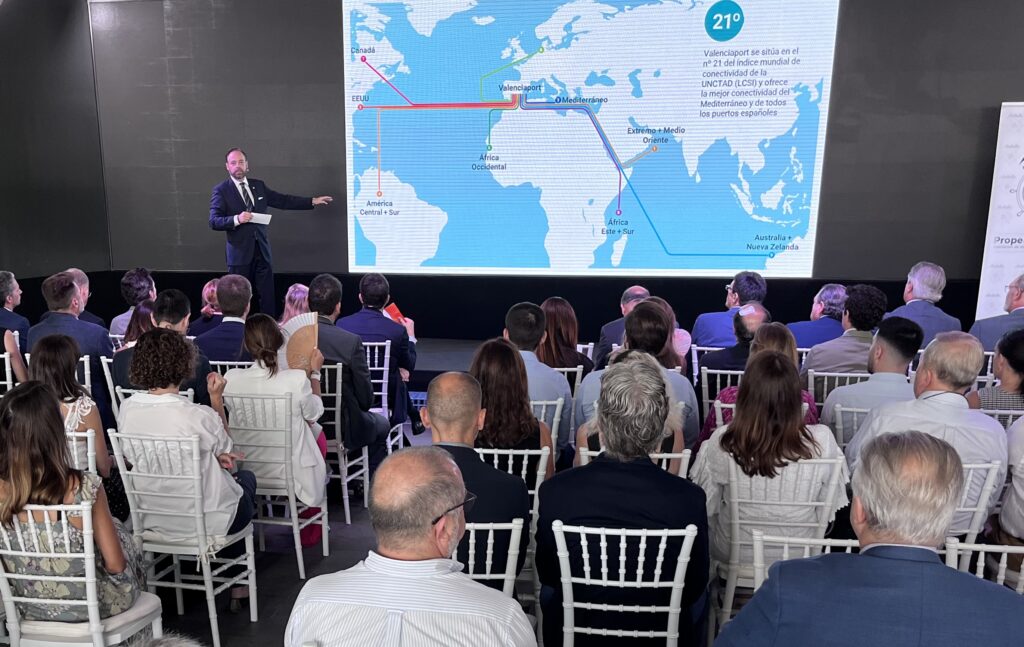
- The president of the Port Authority of Valencia (PAV), Joan Calabuig, has highlighted the volume of jobs generated by the economic activity of the Valencian port at the presentation of the Economic and Social Impact Study of Valenciaport which the association Propeller Valencia held this morning in the Veles e Vents building
- Calabuig called for a framework of stability for Valenciaport’s growth strategy, “it is essential to call for responsibility and consensus in order to be able to continue growing and guarantee stability and therefore the continuity of Valencian port activity”
- Along the same lines, Alfredo Soler, president of Propeller València (Association of logistics managers and businessmen), insisted that “Valencians import at competitive prices thanks to the size of our port and this allows us an affordable logistics cost and to export the final product at attractive prices”
- Diego Vizcaíno, managing partner of the AFI consultancy firm, has described point by point the report and the contribution of Valenciaport to the Valencian economy and its area of influence: (3,200 million euros of Gross Value Added); the employment it generates (50,000 jobs); the multiplier effect it has on the Valencian economy, both in terms of jobs (for every port job, another five are generated) and in terms of GDP (3.07% of the total Valencian GDP). 000 jobs); the multiplier effect it has on the Valencian economy both in terms of jobs (for each port job, another five are generated) and in terms of GDP (3.07% of the Valencian total); and its impact on tax revenue (227 million euros); among other aspects
València, 13 July 2023.- “An essential port for Valencians and the driving force of their economy”. Joan Calabuig, president of the València Port Authority (PAV), made this categorical statement this morning at the presentation of the Economic and Social Impact Study of Valenciaport for 2019, which the Propeller València association carried out this morning in the Veles e Vents building. “The Valencian port facilities generate 50,000 jobs per year, 2.5% of the total in the Valencian Community,” he added.
The results of this report, which was presented this morning by the Association of Logistics Managers and Entrepreneurs – Propeller Valencia – follow on from the information analysed in the previous economic impact study carried out by the Polytechnic University of Valencia (UPV), which focused on 2016. The report presented today, prepared independently by the consultancy Analistas Financieros Internacionales (AFI) and the company Prometeia, has followed the same analysis methodology to compare the results. In this sense, if we contrast both works in terms of employment and Gross Value Added (GVA) data, we can see the notable contribution of Valenciaport to the Valencian economy and how this contribution follows an upward trend.
Necessary framework of stability
In this context, Calabuig called for consensus to guarantee the framework of stability necessary for Valenciaport to function properly. “We need stability to be able to compete in safe conditions. It is essential to call for responsibility and consensus to be able to continue to grow and guarantee the continuity of Valencian port activity. The port is a central tool, fundamental for our economy, for our society and for our future. It should not be a stage for disputes and partisan positioning, nor for any interested party”, he pointed out.
For Calabuig, this security is essential for our companies to remain competitive in the foreign market. “Ninety per cent of world economic growth will take place outside Europe, so being able to export will guarantee the future of our companies. “In this framework we need stability, companies need strategic consensus to face their future. Valenciaport is perhaps the most international brand that we Valencians have. Hence the importance of the stability I demand for the exercise of business activity”.
Calabuig also made a reflection to assess the importance and weight of the Valencian ports: “Spain’s GDP is 1.2 trillion, and experts say that approximately 60% of the world’s GDP is generated by international trade. If 40% of Spanish international trade moves through Valenciaport, anyone can calculate the magnitude and importance of the Valencian ports”.
In this sense, the PAV and its cluster work for 20,000 importing and exporting companies, companies that are served by more than 1,100 logistics companies, terminals, agents, shipping companies, insurance companies that exchange between them more than 80 million digital documents a year. “The weight of Valenciaport in the Valencian economy is similar to that of the main sectors in terms of size, with the added value that the port itself is essential for the activity and development of these sectors”, added the head of the PAV.
“What the port community offers responds to present and future challenges. Valenciaport is currently a global benchmark in terms of training and the implementation of environmental policies for an imminent world which will make growth and sustainability compatible”. Finally, Calabuig thanked the companies and the port community for their participation in the preparation of the report.

Valenciaport, a guarantee of competitiveness
Along the same lines, Alfredo Soler, president of Propeller València, emphasised that Valenciaport manages one of the most important logistics hubs in Spain. A powerful port such as the Valencian one means cheaper goods for both end consumers and industry. “We Valencians are competitive because we import at competitive prices and this allows us to have an affordable logistics cost and to export at competitive prices”, he stressed.
“Valenciaport is also a reference point at European level as it occupies fourth position in terms of the number of TEUs handled. On a national level, the ports of Valencia, Gandia and Sagunto represent 20% of the automobile traffic of the total Spanish port system, 20% of the ro-ro traffic and 40% of the total import/export container traffic”, Soler pointed out.
“We can compete in better conditions than the rest because what makes freight rates more expensive is the labour in the ports and the fact that Valenciaport has so many connections guarantees fewer intermediaries, fewer stopovers, and therefore greater competitiveness in export prices”, indicated the president of Propeller València.
Finally, Soler contextualised the impact of Valenciaport by comparing its weight in the economy with the weight of other key sectors. “ASCER employs 68,850 people, the tourism sector employs 236,232 and PowerCo is expected to employ 42,200. Valenciaport employs around 50,000 people, it is a very important and essential driving force for Valencians and a key tool for the rest of the sectors to continue growing”.
Main magnitudes of the report
Diego Vizcaíno, managing partner of the consultancy firm Analistas Financieros Internacionales (AFI) presented the report, highlighting the participation of the companies that make up the port community, insofar as it is thanks to the information they have provided that this report has been able to be produced.
The Economic and Social Impact Study of Valenciaport, prepared independently by the consultancy Analistas Financieros Internacionales (AFI) and the company Prometeia for Valenciaport, has used the Imput-Output analysis methodology. Thanks to this system, it is possible to estimate the relevance of the PAV ports on the economy of the Comunitat in terms of Gross Value Added (GVA) and full-time equivalent employment at four levels: initial effect + direct effect + indirect effect + induced effect.
AFI’s consulting partner has detailed point by point the contribution of Valenciaport to the Valencian economy and its hinterland or area of influence (3,200 million euros of Gross Added Value); the employment it generates (50,000 jobs); the multiplier effect it has on the Valencian economy both in terms of jobs (for each port job, another five are generated) and GDP (3.07% of the Valencian total); and its repercussion on tax revenue (227 million euros); among other aspects.

